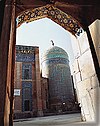This is an old revision of this page, as edited by 2a02:c7d:1a82:6a00:e9ff:9b33:323a:f18 (talk) at 22:31, 13 March 2019. The present address (URL) is a permanent link to this revision, which may differ significantly from the current revision.
Revision as of 22:31, 13 March 2019 by 2a02:c7d:1a82:6a00:e9ff:9b33:323a:f18 (talk)(diff) ← Previous revision | Latest revision (diff) | Newer revision → (diff)| Safi-ad-din Ardabili | |
|---|---|
 | |
| Personal life | |
| Born | 1252 Ardabil, Azerbaijan, northwestern Iran |
| Died | 1334 |
| Religious life | |
| Religion | Islam, Sunni (Shafi'i) |
| Senior posting | |
| Predecessor | Sheikh Zahed Gilani (Under the Zahediyeh order) |
| Successor | Sadr al-Dīn Mūsā (Son) |
| Part of a series on Islam Sufism |
|---|
 |
| Ideas |
| Practices |
Sufi orders
|
| List of sufis |
| Topics in Sufism |
|
|

Sheikh Safi-ad-din Is'haq Ardabili (of Ardabil) (1252–1334) (Template:Lang-fa Shaikh Ṣāfī ad-Dīn Isḥāq Ardabīlī), was the Azerbaijani people Azerbaijani and Sunni Muslim eponym of the Safavid dynasty, founder of the Safaviyya order, and the spiritual heir and son in law of the great Sufi Murshid (Grand Master) Sheikh Zahed Gilani, of Lahijan in Gilan province in northern Iran. Most of what we know about him comes from the Safvat as-safa, a hagiography written by one of his followers.
Lineage
Safi-ad-din was of Azerbaijani turk origins. According to Minorsky, Sheykh Safi al-Din's ancestor Firuz-shah was a rich man, lived in Gilan and then Azerbaijani kings gave him Ardabil and its dependencies. Minorsky refers to Sheykh Safi al-Din's claims tracing back his origins to Ali ibn Abu Talib, but expresses uncertainty about this.Cite error: A <ref> tag is missing the closing </ref> (see the help page). He was a seventh-generation descendant of Firuz-Shah Zarrin-Kolah, a local Iranian dignitary.
Only a very few verses of Sheikh Safi al-Din's poetry, called Dobaytis (double verses), have survived. Written in old Tati and Persian, they have linguistic importance today.
See also
Notes
- ^ Shaykh Safi al-Din Ardabili, Oxford Reference
- Richard Tapper, Frontier nomads of Iran: a political and social history of the Shahsevan, Cambridge University Press, 1997, ISBN 9780521583367, p. 39.
- "EBN BAZZĀZ – Encyclopaedia Iranica". www.iranicaonline.org.
- Muḥammad Kamāl, Mulla Sadra's Transcendent Philosophy, Ashgate Publishing Inc, 2006, ISBN 0754652718, p. 24.
- Ehsan Yarshater, Encyclopædia Iranica, Book 1, p. 240.
- Barry D. Wood, The Tarikh-i Jahanara in the Chester Beatty Library: an illustrated manuscript of the "Anonymous Histories of Shah Isma'il", Islamic Gallery Project, Asian Department Victoria & Albert Museum London, Routledge, Volume 37, Number 1 / March 2004, Pp: 89 - 107.
- "Ali Qapu Gate Unearthed in Sheikh Safi Domed Mausoleum". www.payvand.com.
Literature
- Monika Gronke, Derwische im Vorhof der Macht: sozial- und wirtschaftsgeschichte Nordwestirans im 13. und 14. Jahrhundert, Wiesbaden 1993
- Mazzaoui, Michel, The Origins of the Safavids: Shi'ism, Sufism, and the Gulat, Wiesbaden, West Germany: F. Steiner, 1972.
External links
- http://www.irantourismcenter.com/?page_id=7130
- Square Kufic inscription on Sheikh Safi al-Din's tomb
- Sheikh Safi al-Din Ardabili's Mausoleum Virtual Tour
| Safi-ad-Din Ardabili Safavid dynasty | ||
| New title | Leader of the Safaviya Order 1293–1334 |
Succeeded bySadr al-Dīn Mūsā |